I think having some buildings with step-backs is totally great. Adds variety to the topology of the city and also provides private outdoor space for those who can afford that and prioritize that. But to have it be the across the board rule with the City requiring it only serves to raise the construction costs and baseline price of all new housing, frequently causes compromises on unit layout that makes them functionally worse, and reduces the potential density that is possible on sites. Which is bad for both the housing and environmental crises we're in.
If developers want to build buildings with step-backs sometimes to serve that market of buyers who want that, sure that's good with me, but the City shouldn't be mandating it.
